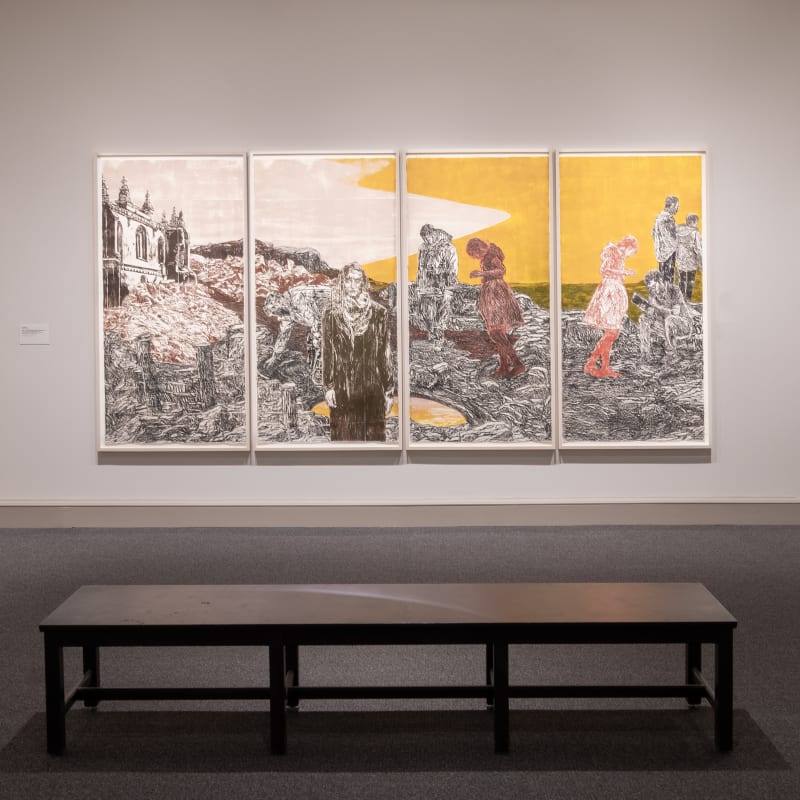Much German expressionist art was made in the wake of, and was profoundly shaped by, World War I. Yet conflict and death are not the primary subjects of the National Gallery of Art's "The Anxious Eye: German Expressionism and Its Legacy." The earliest works in the exhibition, which consists mostly of prints from the museum's collection, were made a few years before Archduke Franz Ferdinand's assassination plunged nearly all of Europe into bloody struggle.
These pieces include vivid color, humorous touches and sensual subjects. Such elements also feature in the show's final gallery, which holds more recent pictures by artists who were influenced by the movement.
Yet war and weaponry are motifs that do lead from the first gallery to the last, from George Grosz's "Attack" to Leonard Baskin's "The Hydrogen Man." The first is a small 1915 lithograph of chaotic World War I combat; the second is a large 1954 woodcut of a sinewy figure stripped of flesh, made in response to an American H-bomb test that unleashed an unexpectedly large quantity of poisonous radiation.
The National Gallery's commentary on the show traces German expressionism to a pair of short-lived art movements that began between 1905 and 1911: the Bridge, based in Dresden, and the Blue Rider in Munich. But the movement was inspired by earlier developments in France and other European countries. One of the Blue Rider's founders was the Moscow-born Wassily Kandinsky, and the influences of Franco-Spanish cubism and Norwegian painter Edvard Munch are hard to overlook.
Like their French peers, the Germans were beguiled by the cultures of Africa and Oceania, which they viewed with an admiration mixed with condescension. Such artists as Ernst Ludwig Kirchner (a founder of the Bridge), Emil Nolde and Max Pechstein depicted nudes in what often appear to be tropical climes. Nolde and Pechstein even traveled to the Pacific, visiting German colonies that would be confiscated by the Allies just a few years later, after World War I.
Most of the nudes, pre- and postwar, are in the second of the four galleries, devoted to "Nature and Spirituality." But the show opens with "Portraiture," a room that contains the works that seem to typify German expressionism. These likenesses, often self-portraits, are stark, angular, intentionally crude and sometimes confrontational. Inspired by then-new theories of human psychology, the renderings use distorted features to convey tortured dispositions.
Although such artists as Käthe Kollwitz made exquisitely vivid woodcuts in just black and white, others added watercolor, often in non-naturalistic hues. Skin tones turn a troubling bilious green in pictures by Walter Gramatté - his has the exemplary title "The Great Anxiety (Self-Portrait, in Three-Quarter Profile to the Right)" - and Erich Heckel. Maybe it's the subject's high forehead and pointed ear, but Heckel's "Man in Prayer" suggests the vampire of F.W. Murnau's "Nosferatu," the classic German expressionist film released just three years after this hand-colored woodcut.
While reflecting on the losses of the First World War, some of the show's contributors seem to anticipate the horrors of the second one. Death is a recurring presence, often personified as a skull-headed figure, in prints by Otto Dix and Lovis Corinth (neither of whom identified as expressionists at the time). Also on hand is "Sorrow," the title of a print in which a woman appears to be folding in on herself. It's by Egon Schiele, who was an expressionist, but an Austrian one.
The show's final gallery is devoted to more recent prints by artists indebted to the works in the three preceding rooms. These tend to be bigger and more detailed than the German expressionist works, but with evident stylistic and thematic affinities. The largest is Israeli artist Orit Hofshi's print, rubbing and drawing of figures in barren terrain, suggesting a postwar landscape. It's as bleak and haunted as Baskin's "The Hydrogen Man," which hangs nearby.
Germanic but lighter-hearted is French-born American artist Nicole Eisenman's phenomenally detailed "Beer Garden," a scene partly viewed through an upturned beer stein. Two African American artists, Kerry James Marshall and David C. Driskell, offer contrasting takes on the German-expressionist portrait: Marshall's is closer to the original style, while Driskell's captures its sense of coexistent stillness and agitation. Like so many of the pictures in "The Anxious Eye," Driskell's self-portrait seems to peer into an unmoving head to convey the turbulence within.

